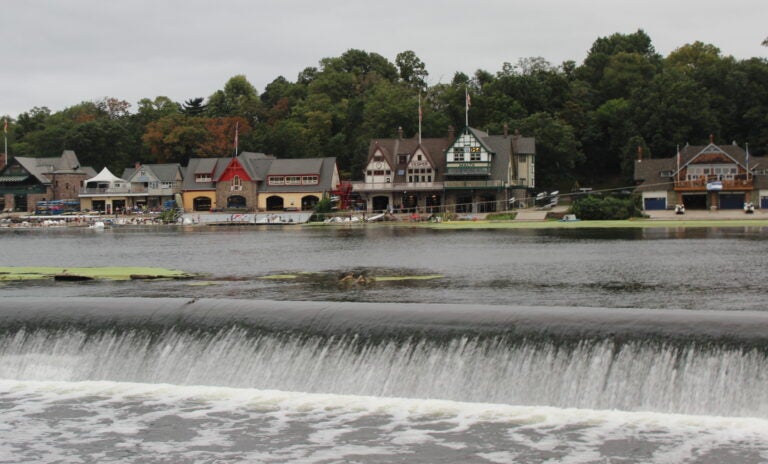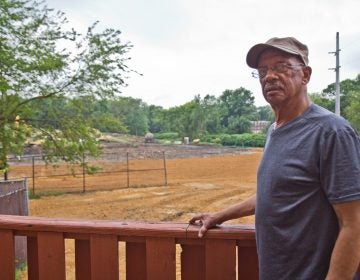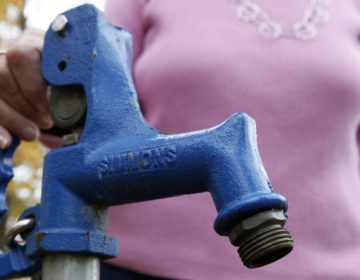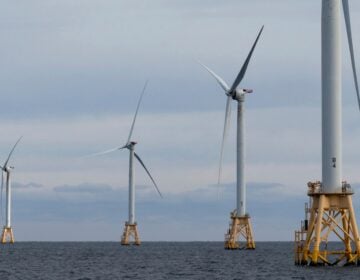‘The river’s gonna seek its own course’: Experts take a new look at easing floods
Traditional systems are designed to manage or redirect water. Natural solutions capture and absorb rains. The issue: predicting the unpredictable.
Listen 3:27
The Fairmount Dam Fishway helps anadromous fish like shad, striped bass, sturgeon and others access Schuylkill River habitat and spawning grounds located above the dam at the Water Works. (Philadelphia Water Department)
It’s peak hurricane season now on the Atlantic Coast. Experts predicted as many as 25 named storms from June to November this year. Halfway through, there have already been more than a dozen, including one that tore through the Philadelphia region, flooding houses and destroying property.
As climate change advances, those impacts are only getting worse — and they’re changing the conversation around flood management.
“People start to recognize that we have stronger storms, more frequent hurricanes that are gonna hit us,” said Ethan Yang, who studies water resource management at Lehigh University. “[They] start wondering whether our traditional centralized stormwater management control, whether that’s enough to protect our lives and properties.”
Traditional stormwater management systems are man-made — the Schuylkill River’s Fairmount Dam, for example, or a protective creekside levee — and designed to manage water levels and transport excessive rainwater out of the way. Scientists often call systems like those “gray infrastructure.”
More natural solutions, like wetlands and rain gardens, are designed to capture flooding rains — they’re meant to soak up the rainwater where it falls, rather than move it somewhere else. Solutions like those are called “green infrastructure.” They can start small, with backyard rain barrels and green roofs, or go much larger, via coastal buffers and regional bioretention plans for stormwater runoff.
One issue with the current flood management system lies in the simple fact that the future cannot be predicted.
“All the modeling that we do is always on the last storm,” said Jeff Tittel, president of the New Jersey Sierra Club.
If, for example, a storm flooded regional waterways and another storm hit only days later, he said, the already overwhelmed system wouldn’t be able to handle it.
Hiba Baroud, an environmental and civil engineer who specializes in risk analysis at Vanderbilt University, agreed.
“Because there’s so much uncertainty with the type of hazards we might be dealing with in the future … any solution that we can offer now that serves a mitigation purpose is not going to be completely bulletproof,” she said.
Is one method better than the other?
Gray infrastructure is initially easier to build and maintain, but it has a limit: Dams that are strong enough to hold back floods now may not hold back the floods that come in the next five or 10 years, Baroud said. As natural disasters get more intense, so does our vulnerability to them — and that vulnerability “makes managing and regulating these kind of events challenging.”
The advantage of green infrastructure is that it addresses small flooding problems before they become big ones: If wetlands can soak up the water before it ever reaches the river, the river won’t overflow. The disadvantage is that it requires major buy-in from thousands of residents, or from local and regional governments willing to shell out to build those natural options. A single rain barrel isn’t going to stop a flood.
And even natural solutions, Tittel said, would require a complete implementation to be effective. One mismanaged flood affects everyone downstream.
“The river’s gonna seek its own course, it has a historic memory,” he said. “The Army Corps [of Engineers] mentality is ‘Let’s shift it somewhere else,’ but the problem is that somewhere else may not have the ability to absorb that water.”
To actually build flood-resilient communities, he said, an approach for the Delaware River Watershed as a whole would be needed.
“It all has to be part of a holistic plan… [going] property by property, town by town, is not going to work,” Tittel said.
Yang thinks both gray and green infrastructure can be pursued, and planned in tandem to both absorb floodwater and minimize its damage.
“In my view, green infrastructure is the first defense line, I guess because we absorb everything on a local scale,” he said. The rest of the floodwater — excess drainage from water barrels or green roofs, and runoff from impermeable surfaces like parking lots — can be dealt with by gray infrastructure, which he calls the “second defense line.”
Redirect water, or relocate the neighborhood?
Then again, those solutions are meant to mitigate flood damage … they can’t prevent it completely.
“If we were talking about a super-hurricane type of event, it doesn’t matter whether it’s gray or green infrastructure — it will get flooded some way, somehow,” Yang said.
Baroud said that’s why the best solution is actually avoidance, “ … the idea that, well, maybe we shouldn’t even worry about flood mitigation, maybe we should move high-risk people away.
Relocating people won’t change the floodwaters, but it would take them out of the flood’s path. Some experts estimate that flood risk in residential areas across the United States is much higher than governmental estimates show.
David Casagrande is an environmental anthropologist at Lehigh University. He studies what makes communities most likely to see relocation as a solution — and what might make them resistant to the idea, even if it’s the safest option.
“Selling your home, relocating, taking the FEMA buyout: These are incredibly difficult decisions for a household to make,” he said. “What people really want is some kind of larger structural solution to the problem … a flood wall, a sea wall, a levee … and that’s where they’ll pour all their energy.”
Relocation is often a last-resort effort not because it’s ineffective, but because it’s difficult, Casagrande said.
“You have to overcome that structural bias; at some point, there have to be enough people in the town who come to the conclusion that there is no structural solution,” he said.
A good relocation plan involves expert leadership, ample funding, strong community ties, a non-geographically based economy, and more, he said. But if communities in high-risk flood zones want to survive, it could be the only option left.
“The climate bill is here, and we cannot deal with it politically, societally, whatever,” Casagrande said. “We’re kind of floundering.”
WHYY is your source for fact-based, in-depth journalism and information. As a nonprofit organization, we rely on financial support from readers like you. Please give today.







